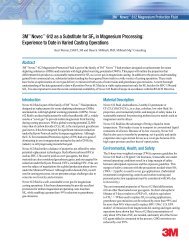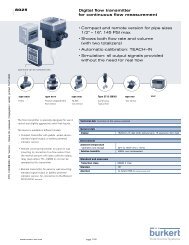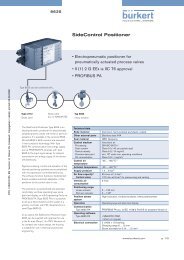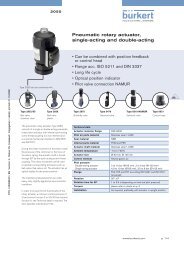Solenoid valves - Bürkert Fluid Control Systems
Solenoid valves - Bürkert Fluid Control Systems
Solenoid valves - Bürkert Fluid Control Systems
You also want an ePaper? Increase the reach of your titles
YUMPU automatically turns print PDFs into web optimized ePapers that Google loves.
Specific values of certain media<br />
Type of gas p 2 max.<br />
Diatomic gases, e.g. N 2 , O 2 , and CO 1.400 0.528 0.484<br />
Air 1.402 0.53 0.49<br />
Triatom. gases, e.g. CO 2 ; superheat. steam 1.300 0.546 0.473<br />
Sattdampf 1.135 0.577 0.45<br />
Table 2<br />
(Konstante)<br />
( p 1<br />
)<br />
A corresponding relationship can also Outflow function <br />
be stated for the volume flow.<br />
If we reduce the pressure ratio p 2 /p 1<br />
crit<br />
3.3.3. Sub-critical and super-critical<br />
outflow<br />
On the basis of this ratio, a distinction<br />
is made in regards to the outflow behavior<br />
of gases in <strong>valves</strong> between a<br />
sub-critical outflow and a super-critical<br />
outflow:<br />
p 2<br />
><br />
p 1 (<br />
p 2<br />
p 1)<br />
crit<br />
3.3.2. Outflow function and critical<br />
pressure ratio<br />
Figure 9 shows as a function of the<br />
pressure ratio p 2 /p 1 . In addition, is<br />
slightly dependent on the adiabatic<br />
exponent which must be entered as<br />
a parameter. is a constant for a specific<br />
ideal gas (see Table 2).<br />
Figure 9<br />
0,6<br />
0,5<br />
0,4<br />
0,3<br />
0,2<br />
0,1<br />
1,6<br />
1,4<br />
1,2<br />
1,0<br />
0,527<br />
0,484<br />
0,459<br />
0,429<br />
0<br />
0,2 0,3 0,4 0,5 0,6 0,7 0,8 0,9 1,0<br />
starting from value 1, i.e. reduce p 2<br />
with constant pressure p 1 , and thus<br />
M, initially rises. Starting at a specific<br />
pressure ratio which is referred to as<br />
the “critical pressure ratio”, the outflow<br />
function and thus also the<br />
mass flow remain constant ( max and<br />
M max ). The critical pressure ratio is<br />
calculated as follows:<br />
p<br />
(<br />
2<br />
p 1<br />
) (<br />
krit<br />
In addition to the adiabatic exponent<br />
, Table 2 shows the critical pressure<br />
ratios and values of max for certain<br />
gases. max may assume values between<br />
0.5 and 0.6 for popular media.<br />
The critical pressure ratios lie approximately<br />
between 0.45 and 0.55. For<br />
practical tasks, it suffices to use a critical<br />
pressure ratio of<br />
(p 2 = 1/2p 1 ).<br />
=<br />
p<br />
(<br />
2<br />
≈ 0,5<br />
p 1<br />
)<br />
crit<br />
<br />
2 -1<br />
<br />
·<br />
+1)<br />
Equation 6<br />
= Sub-critical outflow,<br />
p 2<br />
≤<br />
p 1 (<br />
p 2<br />
p 1)<br />
crit<br />
= Super-critical outflow.<br />
The differences between sub-critical<br />
and super-critical outflows are shown<br />
While, in the case of sub-critical outflow,<br />
the mass flow can be calculated<br />
on the basis of equation 5, in the case<br />
of super-critical outflow, this equation<br />
can be specified more precisely as<br />
follows:<br />
·<br />
M = · A · max 2 · 1 · p 1<br />
Equation 7<br />
By way of approximation, we can use<br />
a value of 0.5 for max .<br />
30/31








